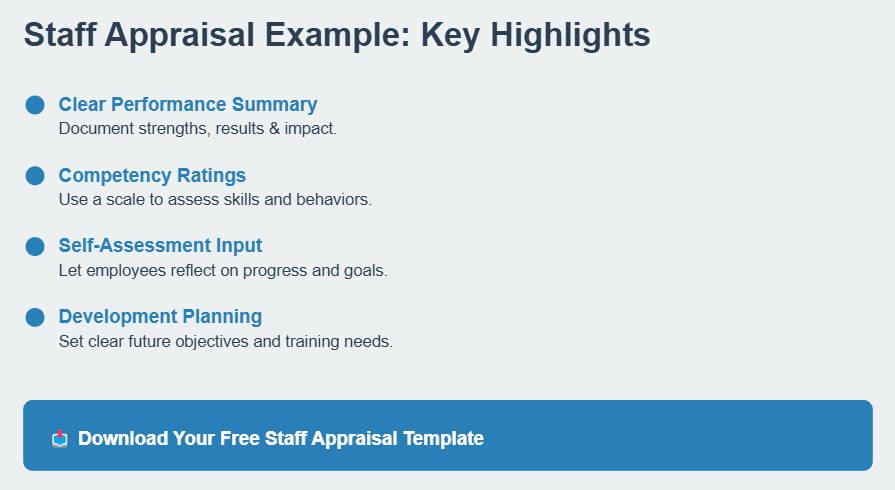Staff appraisals are a cornerstone of effective performance management. When done correctly, they not only evaluate past performance but also align employees with future goals, foster development, and build trust. This post offers a comprehensive staff appraisal example you can adapt to your organization, plus a free downloadable template to simplify the process.
Why Staff Appraisals Matter
Effective staff appraisals help organizations:
- Align individual and team objectives with company goals.
- Identify strengths and development needs.
- Provide structured feedback and recognition.
- Promote employee engagement and retention.
- Support training and succession planning.
To deliver these benefits, appraisals must be specific, fair, and action-oriented.
Staff Appraisal Example: 5 Key Sections
A well-structured appraisal form typically includes the following elements:
1. Employee Information
- Name, job title, department
- Appraisal period and date of review
- Reviewer’s name and position
2. Performance Summary
- Highlights of key achievements
- Overall performance rating (e.g., Exceeds Expectations, Meets Expectations, Needs Improvement)
- Challenges faced during the review period
Example:
“Jane consistently exceeded her quarterly sales targets by 15%, implemented a new CRM workflow that improved team efficiency, and demonstrated leadership by mentoring two junior colleagues.”

3. Key Competency Ratings
Use a scale (1 to 5) to rate competencies such as:
- Communication
- Teamwork
- Problem-solving
- Initiative
- Reliability
Example:
| Competency | Rating | Comments |
|---|---|---|
| Communication | 4 | Clear and concise with clients. |
| Teamwork | 5 | Actively supports team members. |
| Problem-solving | 4 | Proactive in resolving client issues. |
✅ Ready to Elevate Your Appraisals?
Download our free editable staff appraisal template — designed by HR experts and aligned with best practices. Save time, ensure consistency, and improve employee feedback quality.
👉 Download the Free Template Now
4. Employee Self-Assessment
Encourages reflection and two-way dialogue:
- What were your major accomplishments?
- What challenges did you face?
- What support or training would be helpful?
Example Entry: “I’m proud of launching the onboarding toolkit, which reduced new hire ramp-up time by 25%. I’d like support in learning data visualization tools to better present team metrics.”
5. Development Plan
- Specific goals for the next period
- Recommended training or mentorship
- Timeline and accountability structure
Example: “Enroll in Advanced Excel training by Q3 to support financial reporting improvements. Shadow finance lead on monthly closing process.”
Conclusion: Make Appraisals Count
A great staff appraisal is more than a form—it’s a structured conversation that inspires performance, promotes growth, and builds connection. Use this example as a starting point, and tailor it to your culture and strategy.
Frequently Asked Questions (FAQ)
Q1: How do you write a good staff appraisal?
A: A good staff appraisal should be clear, balanced, and developmental. It highlights achievements, identifies growth areas, sets actionable goals, and uses objective examples to support performance insights.
Q2: How to appraise staff performance example?
A: For example: “Lisa consistently meets her project deadlines, maintains high-quality standards, and supports her peers. She exceeded her quarterly KPIs and is ready to take on additional responsibilities.”
Q3: What is an example of a good appraisal?
A: “Alex has shown excellent leadership in project coordination, improved workflow efficiency by 18%, and fostered strong client relationships. He proactively seeks feedback and implements improvements quickly.”
Q4: What are some example sentences for appraisal?
A:
- “Demonstrates strong initiative in tackling challenges.”
- “Consistently produces accurate and timely work.”
- “Exhibits strong interpersonal communication.”
- “Takes ownership of assigned tasks.”
Q5: How to write your appraisal example?
A: “Over the past year, I’ve led two successful initiatives, improved my time management, and built stronger client relationships. I plan to focus next on technical upskilling and data analysis.”
Q6: What are positive comments on a staff appraisal?
A:
- “Always goes above and beyond expectations.”
- “Brings energy and innovation to the team.”
- “Plays a critical role in our success.”
- “Exemplifies company values in daily work.”
Q7: What are the 5 words performance review?
A: Five useful performance review words are: Reliable, Proactive, Collaborative, Adaptable, and Efficient.
Q8: What is a sample answer for a staff appraisal?
A: “This year, I enhanced my presentation skills and led a key client engagement. I also contributed to a new onboarding process. I look forward to expanding my strategic input in future projects.”
Q9: How do you appraise underperforming staff?
A: Address the issue constructively with specific examples. Discuss barriers, agree on improvement goals, and offer support like coaching or training to help them improve.
Q10: What is the most common appraisal?
A: The most common type is the annual performance review, often supplemented by mid-year reviews or continuous feedback sessions.
Q11: What should I write in my overall comment performance review?
A: “This year I consistently delivered high-quality work, improved process efficiency, and supported my peers. I aim to further develop leadership skills and increase strategic contributions.”
Q12: How to evaluate staff performance?
A: Use a mix of KPIs, qualitative feedback, goal attainment, and behavior-based metrics. Include both what was achieved and how it was achieved.
Q13: How do I comment on my own performance?
A: Be specific and honest: “I’ve improved in project delivery and cross-functional collaboration. I recognize the need to develop deeper technical expertise and will pursue training in that area.”
Q14: What are some examples of positive feedback for colleagues?
A:
- “Your support was instrumental in hitting our targets.”
- “I appreciate your proactive communication style.”
- “You’re a dependable team player and always deliver.”
Q15: How do you write 10 performance goals examples?
A: Examples include:
- Complete a certification by Q3
- Improve customer satisfaction scores by 10%
- Mentor a junior team member
- Reduce project delivery time by 20%
- Lead one cross-departmental initiative
- Increase sales conversion rate
- Implement a new reporting tool
- Contribute to knowledge-sharing sessions
- Decrease team error rate by 15%
- Present a process improvement proposal
Would you like the post adapted for a specific industry or job role (e.g., software engineers, retail staff, finance analysts)? Reach out to us here
